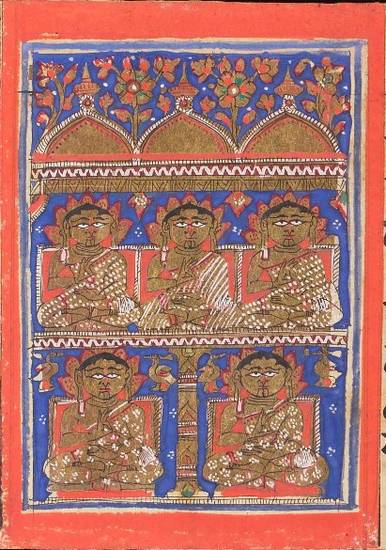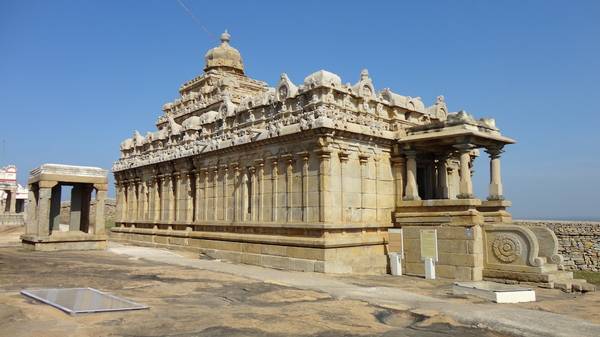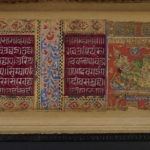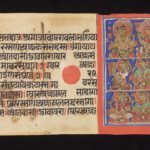Article: Śvetāmbara
The Jain faith contains various sects or traditions, as do other religions. All these groupings believe in the central doctrines of the religion, though they vary in interpretation and practice. The two principal sects of Jainism emerged early in the Common Era, splitting over different practices and beliefs regarding monks and nuns. The Digambaras and Śvetāmbaras remain the main divisions or sects of Jainism. They take their titles from the clothing practices of their monks, which distil key doctrinal differences. The Sanskrit term ‘Śvetāmbara’ means ‘white-clad’ and refers to the white clothing of monks and nuns in this order.
Over time these two sects have built up separate doctrines and histories, resulting in different canons of sacred writings and significant individuals. Within the main sect a number of smaller subsects or traditions have arisen over the centuries. Since the late medieval period the issue of image worship has been a major point of dispute among Śvetāmbaras. Disagreements over whether it is proper to worship images eventually led to schisms that formed the Sthānaka-vāsins and the Terāpanthins. The Śvetāmbara Jains who worship images – the Mūrti-pūjaks – are the largest subsect, however. They comprise a number of smaller subsects.
Although most groups that become sects develop around a charismatic individual mendicant, some groups originate within the lay community. The chief such groups among Śvetāmbaras are the Kaḍuā-gaccha and Lonkā-gaccha.
This piece is a summary of the article "Śvetāmbara". The full article will be available soon.
Terms
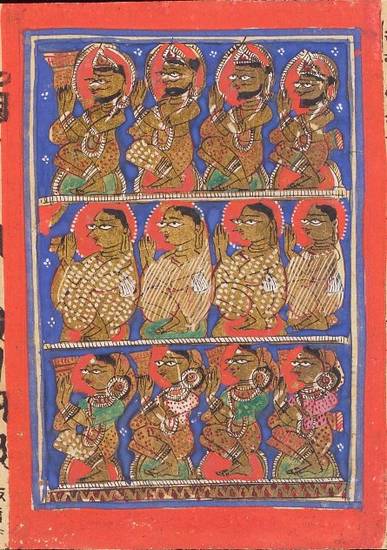
Fourfold community
Image by Wellcome Trust Library © Wellcome Library, London
Among Śvetāmbara Jains several Sanskrit terms are used for a ‘sect’:
The term saṅgha can express the meaning of the whole ‘fourfold community’, which is composed of monks and nuns, lay men and lay women. It can also be used for the ‘monastic community’ – sādhu-saṅgha or muni-saṅgha.
Organisations of mendicants are known as either gaṇa or gaccha, which both mean ‘group’. Most Śvetāmbara Jains would describe a sect as a gaccha. Indeed, the label ‘gaccha’ forms part of the title of some Śvetāmbara Mūrti-pūjak sects, such as the Añcala-gaccha, the Kharatara-gaccha and others. The Śvetāmbara Sthānaka-vāsin prefer sampradāya to gaccha.
Main characteristics
Meaning ‘white-clad’ in Sanskrit, the term Śvetāmbara described the white clothing of monks and nuns in this sect. They wear simple white – śveta – cotton robes – ambara.
There are also other key features of doctrine and practice that distinguish members of the Śvetāmbara sect.
|
Mendicant clothing |
white robes |
|---|---|
plus, for Mūrti-pūjak mendicants only
|
|
|
Holy texts |
|
|
Women |
can achieve liberation |
|
Sex of Jinas |
|
|
The main Śvetāmbara sect has split into smaller subsects over the centuries. New groups formed around successive monastic leaders, creating monastic lineages. The records – paṭṭāvalis or gurv-āvalis – of several mendicant lineages have survived and offer information about the origin and development of the sect.
Śvetāmbara sectarian traditions
The significant Śvetāmbara text of the Kalpa-sūtra provides the principal record of mendicant lineages. The second section of the Kalpa-sūtra is the Sthavirāvalī, which supposedly documents the situation at the time of the 24th Jina, Mahāvīra.
Mahāvīra had 11 disciples – gaṇa-dharas, who led groups of mendicants – gaṇas. Two gaṇa-dharas at a time managed two groups, making a total of nine gaṇas. None of the chief disciples had any spiritual descendant except Ārya Sudharman, so that ‘The Nirgranthas Śramaṇas of the present time are all [spiritual] descendants of the monk Ārya Sudharman’ (Kalpasūtra, Jacobi’s translation: 1884 : 287). Another reason for Sudharman’s prominence is that he did not achieve omniscience in Mahāvīra’s lifetime and hence was in a position to assume leadership of the mendicant community. All the later Śvetāmbara sectarian traditions claim descent from Sudharman except one, the Upakeśa-gaccha. This group claims descent from the 23rd Jina, Pārśvanātha or Lord Pārśva.
The lines of succeeding religious teachers who claim a common mendicant ancestor are listed in the Sthavirāvalī in the Kalpa-sūtra. The most recent is Devarddhi Kṣamāśramaṇa, who arranged for the final redaction of the scriptures at Valabhī, in Gujarat, in the fifth century CE.
However, later documents that focus on the writing down of the holy scriptures indicate that two separate recitation traditions existed. The Gujarati towns of Mathurā and Valabhī seem to have had their own traditions, which implies that strongly held disagreements divided the Śvetāmbara community even in the fifth century.
The question of whether it is proper to worship images emerged as an issue of contention in the late medieval period. Disagreements on this topic caused several subsects to be established over the next few centuries. The present-day names for the main Śvetāmbara subsects date back to this period, when the worship of images became a major sectarian difference. The terms are:
- Mūrti-pūjaka
- Sthānaka-vāsin
- Terāpanthin.
These sects agree on several fundamental areas but hold different beliefs and have diverse practices in some respects.
The Śvetāmbara sects agree on the:
- authority of the Śvetāmbara canonical scriptures, with slight differences
- claims of monastic descent from Sudharman, except for the Upakeśa-gaccha
- white monastic robes of monks and nuns.
The other disputed topics may have developed gradually, in part as signs of difference from the other sects.
|
|
Mūrti-pūjak sect |
Sthānaka-vāsin sect |
Terāpanthin sect |
|---|---|---|---|
|
Canonical scriptures |
45 |
32 |
32 |
|
Worship of images |
yes |
no |
no |
|
Monastic equipment – staff |
yes |
no |
no |
|
Monastic equipment – broom handle |
short |
long |
long |
|
Monastic equipment – use of mouth-cloth |
worn at certain times |
worn permanently |
worn permanently |
|
Nuns – access to canonical scriptures, to various levels |
yes |
yes |
yes |
|
no |
no |
yes |
In addition, the sects have differences regarding the daily liturgy and recitation, and also the religious calendar.
Mūrti-pūjaks
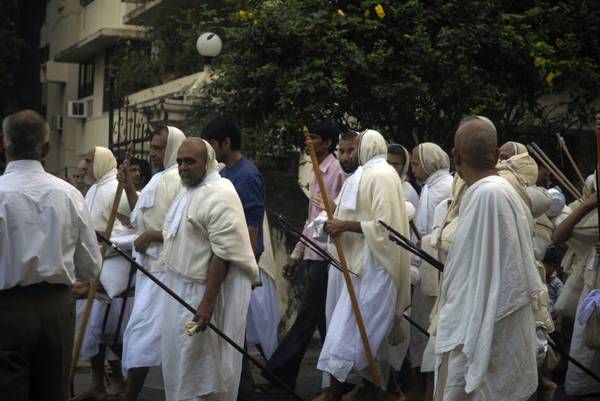
Śvetāmbara monks
Image by Hoorob – Robert Tyabji © CC BY-NC-ND 3.0
The Sanskrit name Mūrti-pūjaka means ‘worshipper of images’, meaning images of the Jinas. Synonyms are the modern Indian words Derāvāsī – which literally means ‘staying in temples’ – and Mandir Mārgī –‘temple-followers’. Such terms have to be understood in contrast with the Sthānaka-vāsins, who reject image worship. This explains why these terms became common only when the latter came into formal existence, between the 15th and 17th centuries.
Mūrti-pūjaks form the largest Śvetāmbara sectarian tradition. Within the Mūrti-pūjak tradition there are several subsects called gacchas. They all recognise the authority of 45 canonical scriptures. The subsects are:
- Tapā-gaccha
- Añcala-gaccha
- Kharatara-gaccha
- Pūrṇimā-gaccha
- Pārśvacandra-gaccha
- Vimala-gaccha
- Tristuti-gaccha.
Sthānaka-vāsins
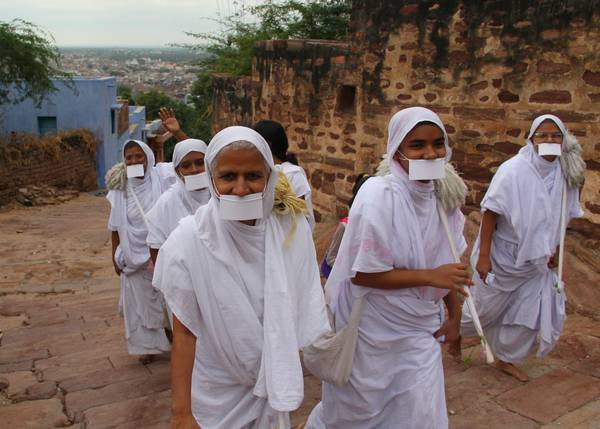
Śvetāmbara Sthānaka-vāsin or Terā-panthin nuns
Image by arjunstc – Arjun © CC BY-NC-ND 3.0
The origin of the Sthānaka-vāsin sect goes back to the lay man Loṅkā Śāh, who lived in the 15th century. It is divided into different monastic orders. Today followers of the Sthānaka-vāsins are found mainly in Gujarat and in the Hindi- and Punjabi-speaking areas of north India.
The main distinctive feature of the sect is rejection of image-worship. The term Sthānaka-vāsin literally means ‘hall-dweller’ in Sanskrit, and should be understood as being the opposite of Mūrti-pūjaka, which means ‘image-worshippers’. A ‘hall’ here is an empty building, contrasted with temples, where images of the Jinas are housed and worshipped. First found in a text written in 1630, the term ‘Sthānaka-vāsin’ became regularly used only at the beginning of the 20th century. The Sthānaka-vāsins are sometimes considered to be ‘protestant’ Jains. They put emphasis on strict asceticism, meditation and fasting.
Unlike the Mūrti-pūjak traditions, the Sthānaka-vāsins recognise only 32 canonical scriptures as authoritative, not 45. They deny texts they consider do not reflect Mahāvīra’s teaching, and they thus hold 13 works to be apocryphal.
The Sthānaka-vāsin mendicants are split into numerous groups, mainly on account of historical, doctrinal and regional differences they think cannot be overcome.
Their mendicants must always wear the mouth cloth – muhpattī.
This table is based on information in Flügel 2006.
|
Sampradāya |
Mendicants in 1996 |
Mendicants in 1999 |
|---|---|---|
|
Śramaṇsangh |
979 |
1096 |
|
Independent |
876 |
967 |
|
1139 |
1160 |
|
|
Total |
2994 |
3223 |
Terāpanthins

Ācārya Tulsi
Image by Pramodjain3 © CC BY-SA 3.0
The Terāpanthins are the followers of the Terāpantha. This Śvetāmbara tradition was founded in Rajasthan, which remains closely associated with it. Muni Bhikhan (1726–1803), later known as Ācārya Bhikṣu, created it in the 18th century. Born into a family following the image-worshipping tradition, he entered the monastic order of the Sthānaka-vāsins, who oppose the practice. He split from this group and founded a new one, together with 12 other monks.
This fact may give the sect its name, since the Hindi term terāpantha or terahpantha means either ‘your path’ or ‘path of 13’. Ācārya Bhikṣu’s establishment of a new sect shows a certain amount of fluidity between monastic traditions and also demonstrates the importance of regional factors in the development of different sects.
The main features of the Terāpanthins are:
- rejection of image-worship
- greater stress on meditational practices and contemplation – prekṣā-dhyāna
- emphasis on social values, such as female education.
The Terāpanthamonastic order has a few notable characteristics, namely:
- the supremacy of a single ācārya, chosen by his predecessor
- an intermediate category of monks and nuns, created in 1980, called samaṇas and samaṇīs, who are permitted to use public transport and thus can travel outside India
- the permanent use of the mouth-cloth among monks and nuns.
Like the other Śvetāmbara aniconic sect, the Sthānaka-vāsin, the Terāpanthins state that the canon consists of 32 scriptures. Their present leader is Ācārya Mahāśramaṇa. In 1999, there was a total of 711 mendicants in this sect (Flügel 2006: 335).
Lay traditions
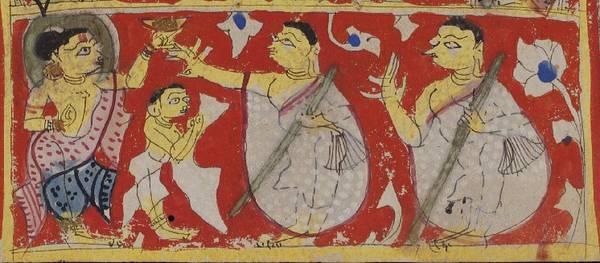
Giving alms to Śvetāmbara monks
Image by Victoria and Albert Museum © V&A Images/Victoria and Albert Museum, London
Historically, a new sect has arisen only after a new mendicant order has been founded. Certain groups, however, prove that lay communities can give rise to new sects. Strictly speaking, lay Jains are not members of sects because only monks and nuns belong to mendicant orders, which form the groupings known as sects. Lay Jains tend to follow mendicants who claim affiliation with certain monastic orders.
However, new Śvetāmbara lay groups seem to have been formed principally in reaction to what members perceive as lax or unscriptural practices, whether among the laity or ascetics. Early members are noted for living by strict ascetic principles while remaining lay people. Associated mendicant orders may be established at later dates, creating a more traditional mendicant-based sect.
Kaḍuā-gaccha
Set up in the 15th century by Kaḍuā Śāh (1438–1507), the lineage of the Kaḍuā-gaccha was a redefinition of ascetic behaviour.
Kaḍuā Śāh was originally a lay man who was a follower of the Añcala-gaccha. Since he observed that mendicants did not live the life of total renunciation prescribed in scripture, he saw no meaning in becoming one formally. Hence he was never initiated and never wore mendicant clothing. However, he followed an ascetic lifestyle, characterised by celibacy and dietary restrictions. The title he took – saṃvarī – underlines this perspective, because it means ‘keeping control and restrictions’.
In 1467 Kaḍuā became a founder and initiated other saṃvarīs, who followed the code of conduct he elaborated. This was a combination of ‘idealized ascetic and lay behavior’ (Wiley 2004 : 115). References to his ‘lineage’ – gaccha – the same term as the one used for mendicant orders, are found up to the 17th century. But it seems to have had some existence until the 1950s in Gujarat.
Lonkā-gaccha
The Śvetāmbara lineage from which the Sthānaka-vāsins originated, the Loṅkā-gaccha was a reform movement that emerged in the 15th century.
The lay man Loṅkā Śāh (c. 1415–1489) had direct access to the Jain scriptures, which he used to copy in manuscript form for monks. He made observations based on the oldest Śvetāmbara scriptures, which he believed do not mention the practices of:
- gaining merit by giving money as religious gifts for the construction of temples
- worshipping images – mūrti-pūjā – or similar ostentatious rituals involving the breaking of flowers and other acts of violence.
These were the starting points of his reforms.
According to Loṅkā, strict asceticism, comprising non-violence, self-restraint and penance, and total non-possession are the keywords of the scriptures. Therefore he denounced the legitimacy of the existing orders that favoured the worship of images, and started to live as an uninitiated ascetic. He followed the oldest textual prescriptions.
The Loṅkā-gaccha – ‘Loṅkā’s monastic order’ – was not founded by Loṅkā himself, but by his first disciple, Bhāṇa. He initiated himself and 45 followers of Loṅkā’s doctrine, who all took the Five Great Vows – mahā-vratas – of Jain ascetics. This happened some time between 1471 and 1476.
Reading
- ‘The A(ñ)calagaccha Viewed from Inside and from Outside’
Nalini Balbir - Jainism and Early Buddhism in the Indian Cultural Context: Essays in Honor of Padmanabh S. Jaini
edited by Olle Qvarnström
Asian Humanities Press; Fremont, California, USA; 2003
- History of Jaina Monachism from Inscriptions and Literature
Shantaram Bhalchandra Deo - Deccan College Dissertation series; volume 17
Deccan College Postgraduate and Research Institute; Pune, Maharashtra, India; 1956
- The Jains
Paul Dundas - Library of Religious Beliefs and Practices series; series editor John Hinnels and Ninian Smart; volume 14
Routledge Curzon Press; London, UK; 2002
- ‘Jainism without Monks?: The case of Kaḍuā Śāh’
Paul Dundas - Approaches to Jaina Studies: Philosophy, Logic, Rituals and Symbols
edited by N. K. Wagle and Olle Qvarnström
Centre for South Asian Studies, University of Toronto Press; Toronto, Canada; 1999
- ‘The Unknown Loṅkā: Tradition and the Cultural Unconscious’
Peter Flügel - Jaina Studies
edited by Colette Caillat and Nalini Balbir
Papers of the XIIth World Sanskrit Conference series; series editor Petteri Koskikallio and Asko Parpola; volume 9
Motilal Banarsidass; New Delhi, India; 2008
- The Jaina Path of Purification
Padmanabh S. Jaini - University of California Press; Berkeley, California USA; 1979
- Gender and Salvation: Jaina Debates on the Spiritual Liberation of Women
Padmanabh S. Jaini - University of California Press; Berkeley, California, USA; 1991
- The Unknown Pilgrims: The voice of the sādhvīs – the history, spirituality, and life of the Jaina women ascetics
N. Shāntā - translated by Mary Rogers
Sri Garib Dass Oriental series; volume 219
Sri Satguru Publications; New Delhi, India; 1997
- Historical Dictionary of Jainism
Kristi L. Wiley - Historical Dictionaries of Religions, Philosophies, and Movements series; series editor Jon Woronoff; volume 53
Scarecrow Press; Maryland, USA; 2004
Links
- Dreams of Triśalā
-
Jainworld.com provides pictures and explanations of the dreams of Queen Triśalā. Women carrying babies who grow up to become Jinas all experience auspicious dreams, which signal the great spiritual leadership of their children. The Digambara sect specifies 16 dreams while the Śvetāmbaras have14 dreams.
- Views of Shatrunjaya temples
-
Collection of photographs of the temple-city of Mount Shatrunjaya. The pre-eminent Śvetāmbara pilgrimage site, Shatrunjaya has nearly a thousand temples. The main temple is dedicated to Ṛṣabha, the first Jina, often called Ādinātha or First Lord. These photographs are presented by Professor Frances W. Pritchett of Columbia University in New York.
- Views of the temple at Ranakpur
-
One of the foremost Śvetāmbara pilgrimage sites, the main temple at Ranakpur has around 1,400 intricately carved marble columns. This collection of photographs of the Ādinātha temple at Ranakpur in Rajasthan is presented by Professor Frances W. Pritchett of Columbia University in New York.
- Explanations of Jain symbols
-
The website Namoka Tirth provides explanations for the common Jain symbols. Unexpectedly, this Digambara organisation offers the Śvetāmbara list of eight auspicious symbols.
Note that some of the website's assertions are not accepted by professional scholars because there is no indisputable historical proof. An example here is the dating of the first Jina, Ṛṣabha.
As with many Jain websites, the use of diacritics and transliterations here is inconsistent and does not meet academic standards.
- Seven Wonders of India – Palitana Temples
-
The Svetāmbara pilgrimage centre at Mount Shatrunjaya is showcased in this NDTV video on YouTube. Jain pilgrims are shown climbing the steep hill – some carried in a kind of palanquin called a ḍolī – and worshipping in some of the hundreds of temples on the twin hills. The presenter gives a brief outline of the Jain faith and mentions the navanū – ‘99fold’ – pilgrimage, which is one of the hardest and most demanding ones.
Beginning in 2008, the New Delhi Television show Seven Wonders of India asked viewers to vote for their favourite seven sites in the country over a year. Part of a publicity campaign organised by the Ministry of Tourism, the show's presenters visited many sites considered potential winners.
- A Śvetāmbara nun descends from Shatrunjaya
-
A nun from a Śvetāmbara Mūrtipūjaka mendicant order runs barefoot down the steps leading down from Mount Shatrunjaya. This temple-city in Gujarat is one of the most significant Śvetāmbara Mūrtipūjaka pilgrimage sites. The steep path from the foot to the summit, where the principal shrines are found, has around 4000 steps.
- Hariṇaigameṣin transfers the embryo
-
This rare palm-leaf page in the collections of the Philadelphia Museum of Art comes from an early 14th-century manuscript of the Śvetāmbara scripture of the Kalpa-sūtra. The picture illustrates the episode where the antelope-headed god Hariṇaigameṣin transfers the embryo of the Jina-to-be Mahāvīra from the brahmin lady Devānandā to the kṣatriya queen Triśalā.
http://www.philamuseum.org/collections/permanent/131608.html?mulR=656|4
- Svetāmbara Jina emblems
-
This picture from the Jeevraksha blog gives the emblems – lāñchana – of the 24 Jinas according to the Svetāmbara sect.
http://2.bp.blogspot.com/_xHZFB-N3uug/TNNW_DqmmeI/AAAAAAAAAzw/v43mxT0R1RY/s1600/jain_symbols2.jpg
- Paryuṣaṇ recipes
-
Recipes suitable for cooking during the Śvetāmbara festival of Paryuṣaṇ from the ramkicooks blog. During this annual festival of eight days, observant Jains tend to follow stricter than normal rules regarding food. Most families give up fresh vegetables, eating only grains, pulses and dairy produce. Taking additional vows to fast completely or partly for any given day of the festival, particularly the first and last days, is common.
- Re-enactment of the story of Candanabālā
-
This slideshow displays the re-enactment of the story of Candanabālā, who offered Mahāvīra appropriate food to break his fast. Sold into slavery, the beautiful princess has her lovely hair chopped off and is starved for three days. Even so, her first act when released is to offer alms to a passing mendicant. He is Mahāvīra, who becomes the 24th Jina, and he has been fasting for nearly six months. Candanabālā’s act of selfless charity despite her suffering causes her hair to be restored and her true identity revealed. The story of this virtuous woman – one of the soḷa satī – emphasises the importance of offering alms correctly. Acting out such stories is an important part of many Jain festivals. This re-enactment on YouTube was performed by Śvetāmbara Jains in Melbourne, Australia during the festival of Paryuṣaṇ in 2010.
- Svastika during Paryuṣaṇ
-
A svastika formed out of traditional clay lamps – dīpas in Sanskrit – is arranged on the petal-strewn floor of a temple during the festival of Paryuṣaṇ. The svastika is an ancient symbol of good luck and is frequently found in Jain temples, on religious equipment and on books, clothing and so on. The four dots among the arms of the svastika represent either the four states of existence or the parts of the fourfold community. Lasting eight days in late August or early September, Paryuṣaṇ is the most important Śvetāmbara Jain festival. This photograph on Flickr was taken in 2007.
- Kārttika Pūrṇimā – part 1
-
The festival of Kārttika Pūrṇimā marks the end of the rainy season and the start of ordinary activities, which stop during the monsoon period. Men chant and clap loudly before the idol of a Jina from the temple is borne in procession – ratha-yātrā.
This two-part YouTube video records the 2010 Kārttika Pūrṇimā festival celebrated in Kolkata in West Bengal by Śvetāmbara Jains. This is the first part and you can watch the second part.
- Kārttika Pūrṇimā – part 2
-
The Kārttika Pūrṇimā festival celebrates the end of the rainy season, when ordinary life can begin again. The image of a Jina from the temple is carried in procession through the streets – ratha-yātrā – while people wave fly-whisks before it, a symbol of royalty. People throw rice grains or sacred powder on to the idol. Though common in many Jain festivals, the idol procession is often a key part of Kārttika Pūrṇimā.
This two-part YouTube video records the 2010 Kārttika Pūrṇimā festival in Kolkata in West Bengal, as celebrated by Śvetāmbara Jains. This is the second part and you can watch the first part.
- Parshvanath Vidyashram Research Institute
-
The Parshvanath Vidyashram Research Institute focuses on research into Śvetāmbara Jainism. Based in Varanasi, in Uttar Pradesh, it has a manuscript library and publishes books and the Śramaṇ journal in Hindi and English.
- Introduction to Jainism – part 1
-
This extract from a BBC documentary called The Frontiers of Peace introduces the ancient Indian religion of Jainism. A Śvetāmbara monk explains some of the main principles of Jainism, especially non-violence. The programme mentions the influence of Jains in India and on the work of Mahātma Gandhi. This 2010 YouTube video is the first of four parts. See the next part at: http://www.youtube.com/watch?v=UHMQRmRKh_U
- Introduction to Jainism – part 2
-
This extract from a BBC documentary called The Frontiers of Peace explores the relationship between Jain traditions and modernity. A Jain lay man tells how he reconciles his faith with his industrial business interests. A Śvetāmbara monk explains the significance of his monastic broom – known as a rajoharaṇa or oghā – including the eight auspicious symbols wrapped around the handle. A nun leads lay followers in the rite of confession – pratikramaṇa. A young woman creates auspicious symbols in rice as an offering as she talks about her decision to become a nun. This 2010 YouTube video is the second of four parts. See the next part at: www.youtube.com/watch
- Hymn to Naminātha
-
This 2007 hymn on YouTube is a Sanskrit stotra to the 21st Jina, Naminātha or Lord Nami. The sound is accompanied by pictures of statues of Jinas and monks of various Jain sects. The plain statues of nude Jinas with closed eyes and the naked monks belong to Digambara sects. The white-robed mendicants are Śvetāmbara Mūrtipūjakas. The monks and nuns with mouth-cloths attached to their ears are from either the Terāpanthin or Sthānaka-vāsīn Śvetāmbara sects.
- Two Śvetāmbara Terāpanthin samaṇī nuns
-
This YouTube video dating from 2009 shows two Śvetāmbara Terāpanthin samaṇīs tallking about their religious background and beliefs. They hold folded cloths in front of their mouths while they speak. Normally Śvetāmbara Terāpanthin monks and nuns wear a mouthcloth – muṃhpatti – permanently over their mouths, hanging from strings over the ears. Samaṇīs have important roles in teaching the Jain diaspora.
- Terāpanthin monks and nuns
-
This YouTube video shows Śvetāmbara Terāpanthin monks and nuns walking down a street in New Delhi in July 2009. Clad in white and wearing the mouth cloth – muṃhpatti – they walk barefoot, carrying their monastic equipment in bags and bundles. They are accompanied by lay Jains, many of the women dressed in orange, which is a holy colour in India. Among the monks is Ācārya Mahāprajña, the tenth ācārya or leader of the sect, who died in May 2010.
- Mahavir Aradhana Kendra – institute
-
Based around the pilgrimage site of Mahaviralaya – a temple dedicated to Mahāvīra, the last Jina – Mahavir Aradhana Kendra is a manuscript library and research institute, which publishes academic books, chiefly on Śvetāmbara Jainism. There is also a museum that includes the monastic equipment used by Gacchādhipati Ācārya Śrī Kailāsaāgara-sūrīśvara Mahārāj.
- New monks and nuns receive their names
-
During a Śvetāmbara Terāpanthin renunciation ceremony – dīkṣā – Ācārya Mahāshraman, the present leader of this order, reads out the names of the new nuns and monks. Since mendicants are considered to be new persons, new monks and nuns are always given new names. Performed in Hindi, this ceremony found on YouTube takes place in Rajasthan in September 2010.
- Śvetāmbara initation candidates in the crowd
-
As part of the renunciation ceremony to become a monk or nun – dīkṣā – the initiation candidates pass through a joyful crowd, who throw sandalwood powder over them. The initiates have already shaven and plucked out their hair and wear the white monastic robe of Śvetāmbara mendicants. This undated ceremony on YouTube takes place in Gujarat.
- Poṣa-daśamī – part 1
-
The Poṣa-daśamī festival celebrates the birth of the 23rd Jina, Pārśvanātha or Lord Pārśva. Held in late December or early January in the Western calendar, Poṣa-daśamī is also known as Pārśvanātha-jayantī. Typically of many Jain festivals, an idol from a local temple is the centre of a procession through the streets – ratha-yātrā. The procession includes decorated animals, musicians, lay Jains and white-clad nuns. The Jina image is hung with bright flower garlands and is fanned with fly-whisks, symbolic of royalty. Lay Jains dance, sing and clap as the statue is brought into the temple at the end of the procession.
This two-part YouTube video records the 2010 Poṣa-daśamī festival in Jaipur, Rajasthan as celebrated by Śvetāmbara Jains. This is the first part .
http://www.youtube.com/watch?v=YihWayx7NKQ
Watch the second part here https://www.youtube.com/watch?v=UddsDpAwYAY
- Poṣa-daśamī – part 2
-
Commemorating the birth of the 23rd Jina, Pārśvanātha or Lord Pārśva, the Poṣa-daśamī festival is also known as Pārśvanātha-jayantī. It is celebrated in late December or early January in the Western calendar. Following a street procession – ratha-yātrā – the garlanded statue of Pārśva is brought into the local temple, while a conch is blown and a bell rung. The local community gathers around it and sings hymns in celebration. Chanting, they move a tray of fire in circles, offering pūja or worship to the statue. All the other images of Jinas in the temple are also decorated with flowers.
This two-part YouTube video records the 2010 Poṣa-daśamī festival in Jaipur, Rajasthan as celebrated by Śvetāmbara Jains. This is the last part.
http://www.youtube.com/watch?v=vXsnBlBDOHk
https://www.youtube.com/watch?v=UddsDpAwYAY
- +
- aAbhavya
- aAbhinandana
- aAbhiṣeka
- aĀcāra
- aĀcārāṅga-sūtra
- aĀcārya
- aAchalbhrata
- aAḍhāī-dvīpa
- aAdharma
- aAdho-loka
- aAdhyayana
- aAdvaita Vedānta
- aĀgama
- aAghātīya
- aAghātīya-karman
- aAgnibhuti
- aAgra
- aĀhāra
- aAhiṃsā
- aAhimsa Day
- aAjita
- aAjīva
- aAkampit
- aĀkāśa
- aAkbar the Great
- aAkṣaya-tṛtīyā
- aAlauddin Khalji
- aAlbert Einstein
- aAllah
- aAlms
- aĀlocanā
- aAloka-ākāśa
- aAmāri
- aAmbikā or Kūṣmāṇḍinī
- aAnagāra
- aAnanta
- aAnarthadaṇḍa
- aAnaśana
- aAnekānta-vāda
- aAṅga
- aAniconism
- aAnojjā
- aAntarāla
- aAntarāya-karma
- aAṇu
- aAṇu-vrata
- aAnukampā
- aAnuprekṣā
- aAnusvāra
- aApabhraṃśa
- aAparigraha
- aAra
- aĀrambha
- aĀrambhaja
- aĀratī
- aArdhamāgadhī Prākrit
- aArhaṃ
- aArhat
- aArśana-āvaraṇīya-karma
- aĀrta-dhyāna
- aĀryikā
- aĀryikā Jñānamati
- aĀśātanā
- aĀścarya
- aAscetic
- aAsceticism
- aAshram
- aAspiration
- aĀsrava
- aAṣṭa-maṅgala
- aAṣṭāpada
- aAstikāya
- aAstrolabe
- aAsura
- aAtheism
- aAticāra
- aAtiśayakṣetra
- aAtithisaṃvibhāgavrata
- aĀtma-vāda
- aĀtman
- aAuṃ
- aAurangzeb
- aAuspicious
- aAusterity
- aAvadhāna
- aAvadhi-jñāna
- aĀvaraṇī-yakarman
- aAvasarpiṇī
- aAvatāra
- aAvidyā
- aAxiom
- aĀyāga-paṭa
- aĀyambil
- aĀyu-karma
- aĀyurveda
- bBabur
- bBāhubali
- bBaladeva
- bBālāvabodha
- bBandha
- bBasadi
- bBazaar
- bBhadrankarvijay
- bBhagavant
- bBhaktāmara-stotra
- bBhakti
- bBhale
- bBharata
- bBhāṣā
- bBhāṣya
- bBhaṭṭāraka
- bBhāva
- bBhāva-pūjā
- bBhāvanā
- bBhavana-vāsin
- bBhavya
- bBhavyatva
- bBhaya
- bBhoga-bhūmi
- bBhogopabhoga
- bBodhi
- bBollywood
- bBrahmā
- bBrahma-deva
- bBrahmacārī
- bBrāhmaṇa
- bBraj Bhāṣā
- bBright fortnight
- bBritish Raj
- bBuddha
- bBuddhi-sagar
- bBuddhism
- bBuddhist
- cCaitya
- cCaityavāsin
- cCakravartin
- cCakreśvarī
- cCāmara
- cCandanā
- cCandragupta
- cCandraprabha
- cCanon
- cCāritra
- cCāritramohanīya-karman
- cCarũrī
- cCaste
- cCaturvidha-saṅgha
- cCaturviṃśati-stava
- cCāturyāma
- cCE
- cCelibacy
- cCha
- cChadmastha
- cChastity
- cCheda-sūtra
- cChristian
- cChristianity
- cClergy
- cCloning
- cColophon
- cCommentary
- cConch
- cConfession
- cCongregation
- cConsecration
- cCosmology
- cCremation
- cCrore
- cCult
- cCūrṇi
- dDādā-guru
- dDalit
- dDāna
- dDaṇḍa
- dDark fortnight
- dDarśana
- dDarśanamohanī-yakarman
- dDaśa-lakṣaṇa-parvan
- dDeity
- dDelhi Sultanate
- dDerāsar
- dDeśāvakāśika-vrata
- dDetachment
- dDevanāgarī
- dDevānandā
- dDevarddhi-gani
- dDevotee
- dDhamal
- dDhanuṣ
- dDhāra
- dDharma
- dDharma-dhyāna
- dDharma-sāgara
- dDharmastikaya
- dDhātakīkhaṇḍa
- dDholak
- dDhyāna
- dDiaspora
- dDig-vrata
- dDigambara
- dDīkṣā
- dDisciple
- dDīvālī
- dDivya-dhvani
- dDNA
- dDoctrine
- dDogma
- dDonor
- dDoṣa
- dDravya
- dDravya-pūjā
- dDrone
- dDuṣamā
- dDuṣamā-duṣamā
- dDuṣamā-suṣamā
- dDveṣa
- dDvīpa
- eEast India Company
- eEightfold Path
- eEkānta-vāda
- eEkendriya
- eElder
- eElders
- eEschatology
- eEtc up to
- fFarmān
- fFast
- fFatehpur Sikri
- fFestival
- fFestschrift
- fFiruz Shah
- fFly-Whisks
- fFolio
- fFour Noble Truths
- gGaccha
- gGaṇa
- gGaṇadhara
- gGanadharavada
- gGaṇeśa
- gGaṇin
- gGarba
- gGarbha
- gGarbha-gṛha
- gGaruḍa
- gGati
- gGene
- gGenomics
- gGhātī-yakarman
- gGhātīya
- gGhaznavid
- gGhiyasuddin Tughlaq
- gGhurid
- gGloss
- gGotra-karma
- gGujarāt
- gGujarati
- gGuṇa
- gGuṇa-sthāna
- gGuṇa-vrata
- gGupti
- gGuru
- gGuruṇī
- hHagiography
- hHajj
- hHaṃsa
- hHaribhadra
- hHariṇaigameṣin
- hHasta
- hHeresy
- hHiṃsā
- hHindi
- hHindu
- hHinduism
- hHīravijaya
- hHoroscope
- hHrīṃ
- hHumayun
- hHymn
- iIconoclasm
- iIconography
- iIdol
- iIndian Independence
- iIndology
- iIndra
- iIndrabhūti Gautama
- iIndriya
- iInitiation
- iIntercession
- iInvocation
- iIQ
- iIslam
- iIslamicate
- iIṣṭadevatā
- iĪśvara
- jJagat
- jJahangir
- jJain
- jJaina Devanāgarī
- jJaina Śaurasenī
- jJaina-dharma
- jJainaśāsana
- jJainness
- jJaisalmer
- jJamāli
- jJambū-dvīpa
- jJames Burgess
- jJanma
- jJanma-kalyāṇa
- jJarā
- jJāti
- jJina
- jJina-āgama
- jJina-bhavana
- jJina-bimba
- jJina-mātā
- jJinacandra-sūri
- jJinadatta
- jJinaprabha
- jJīva
- jJñāna
- jJñāna-āvaraṇīya-karma
- jJñāna-āvarṇiya
- jJñānsundar
- jJyotiṣka
- kKāla
- kKālakācārya-kathā
- kKālidāsa
- kKalpa-sūtra
- kKalpa-vṛkṣa
- kKalyāṇaka
- kKalyanvijay
- kKamaṇḍalu
- kKamaṭha
- kKarma
- kKarma-bhūmi
- kKarma-grantha
- kKarma-prakṛti
- kKarma-vāda
- kKarmon
- kKarnataka
- kKaṣāya
- kKathā
- kKāvya
- kKāya
- kKāyotsarga
- kKeśa-loca
- kKetu
- kKevala-jñāna
- kKevalin
- kKhalji
- kKharatara-gaccha
- kKnowledge
- kKriyā
- kKriyā-vāda
- kKṛṣṇa
- kKṣamā-śramaṇa
- kKṣapakaśreṇi
- kKṣatriya
- kKṣullaka
- kKulakara
- kKundakunda
- kKunthu
- lLabdhi
- lLaity
- lLakh
- lLāñchana
- lLands of Action
- lLaukāntika
- lLavaṇa-samudra
- lLeśyā
- lLiṅga
- lLinguistics
- lLoka
- lLoka-ākāśa
- lLoka-puruṣa
- lLoka-vāda
- lLotus
- lLotus lake
- mMadhya-loka
- mMahā-videha
- mMahā-vrata
- mMahābhārata
- mMahāmastakābhiṣeka
- mMāhārāṣṭra
- mMāhārāṣṭrī Prākrit
- mMahattarā Yākinī
- mMahāvīr Jayantī
- mMahāvīra
- mMakāra
- mMakkhali Gośāla
- mMalli
- mMāna-stambha
- mManaḥ-paryāya-jñāna
- mMaṇḍala
- mMaṇḍapa
- mMandit
- mMaṅgala
- mMantra
- mMantras
- mManuṣya-loka
- mMarāṭhī
- mMārgaṇā
- mMartyr
- mMarudevī
- mMaṭha
- mMati-jñāna
- mMauryaputra
- mMecca
- mMendicant lineage
- mMetarya
- mMiracle
- mMithyādṛṣṭi
- mMohandas Gandhi
- mMohanīya-karma
- mMokṣa
- mMonastic order
- mMonasticism
- mMonk
- mMonotheism
- mMosque
- mMount Meru
- mMount Sammeta
- mMṛgāvatī
- mMughal
- mMuhammad
- mMuhammad bin Tughlaq
- mMuhpattī
- mMūla-sūtra
- mMūlaguṇa
- mMumbaī
- mMuni
- mMunisuvrata
- mMurad Bakhsh
- mMūrti-pūjaka
- mMuslim
- mMysticism
- nNābhi
- nNāga-kal
- nNāgapurīya Tapā-gaccha
- nNāgarī
- nNāma-karma
- nNamaskāra-mantra
- nNami
- nNandīśvara-dvīpa
- nNandivardhana
- nNandyāvarta
- nNāraka
- nNāraki
- nNasalisation
- nNātha
- nNavrātrī
- nNaya-vāda
- nNemi
- nNidāna
- nniggaṃthāṇa vā 2
- nniggaṃtho vā 2
- nNigoda
- nNihnava
- nNikṣepa
- nNirgrantha
- nNirjarā
- nNirvāṇa
- nNiryukti
- nNiṣidhi
- nNitya
- nNiyati
- nNo-kaṣāya
- nNudity
- nNun
- oOcean of milk
- oOmniscience
- oOrdination
- ppa°
- pPadmaprabha
- pPadmāsana
- pPadmāvatī
- pPādukā
- pPalanquin
- pPalette
- pPañca-muṣṭi
- pPāṇḍava
- pPaṇḍit
- pPandit Dalsukh D. Malvania
- pPandit Sukhlalji
- pPāṇipātra
- pPāpa
- pParamātman
- pParameṣṭhin
- pPāraṇā
- pParigraha
- pPariṇāma
- pParīṣaha
- pParokṣa
- pPārśva
- pPārśvanātha
- pParyāya
- pParyuṣaṇ
- pPaṭa
- pPatan
- pPātra
- pPenance
- pPersian
- pPhala
- pPhilology
- pPicchikā
- pPilgrimage
- pPīr
- pPolymath
- pPoṣadha
- pPossession
- pPothī
- pPrabhas
- pPradakṣiṇā
- pPradeśa
- pPrākāra
- pPrakīrṇaka-sūtra
- pPrākrit
- pPramāda
- pPramukhā
- pPrati-vāsudeva
- pPratikramaṇa
- pPratimā
- pPratiṣṭhā
- pPratyākhyāna
- pPratyakṣa
- pPravacana
- pPrāyaścitta
- pPrayer
- pPre-modern
- pPreach
- pPredestination
- pProtestant
- pProvenance
- pPudgala
- pPūjā
- pPujārī
- pPukharavara-dvīpa
- pPuṇya
- pPūrva
- pPuṣkara-dvīpa
- pPuṣpadanta
- pPyre
- qQur’an
- rRāga
- rRāhu
- rRainy season
- rRajasthan
- rRajasthani
- rRājimatī
- rRajoharaṇa
- rRajput
- rRāma
- rRāmāyaṇa
- rRangoli
- rRās-garbā
- rRasa
- rRathanemi
- rRatna-traya
- rRātri-bhojana
- rRaudra-dhyāna
- rRecto
- rRelic
- rRenunciation
- rRetroflex
- rRevatī
- %Ṛg-veda
- rRite
- rRosary
- %Ṛṣabha
- %Ṛṣabhanātha
- rRupee
- sSaciyā Mātā
- sSādhu
- sSādhvī
- sSāgāra
- sSaint
- sŚaivaism
- sŚaka-saṃvat
- sSallekhanā
- sŚalya
- sSamacatuṣṭha
- sSamādhimaraṇa
- sSamaṇi
- sSāmarambha
- sSamavasaraṇa
- sSāmāyika
- sSaṃbhava
- sSamiti
- sSaṃjñā
- sSaṃkalpaja
- sSaṃsāra
- sSamudghāta
- sSaṃvara
- sSaṃvega
- sSamyak-cāritra
- sSamyak-darśana
- sSamyak-jñāna
- sSamyaktva
- sSaṃyama
- sSanctuary
- sSandalwood
- sSaṇgha
- sSanskrit
- sSant
- sŚānti
- sSapta-bhaṅgi-naya
- sSārambha
- sSarasvatī
- sSarvajña
- sSāsan-devi
- sŚāsana-devatā
- sŚāstra
- %Ṣaṭ-jīvanikāya
- sSatī
- sSatīmātā
- sSatya
- sSchism
- sScribe
- sScripture
- sSect
- sSecularism
- sŚenāī
- sSermon
- sŚeṣavatī
- sSevā
- sSeven fields of donation
- sShah Jahan
- sShantidas Jhaveri
- sShrine
- sSiddha
- sSiddha-śilā
- sSiddhacakra or Navadevatā
- sSiddhānta
- sSiddhārtha
- sSiddhi
- sSikh
- sSikhism
- sŚikṣā-vrata
- sŚīla
- sSin
- sSindh
- sŚītala
- sŚiva
- sSkandha
- sSomanatha
- sŚraddhā
- sŚramaṇa
- sŚrāvaka
- sŚrāvakācāra
- sŚrāvikā
- sŚreyāṃsa
- sŚrī
- sŚrīvatsa
- sŚruta-jñāna
- sŚruta-pañcamī
- sSthānaka-vāsin
- sSthāpanācārya
- sSthāvara
- sSthavira
- sSthiti
- sStrīmukti
- sStūpa
- sSubcontinent
- sSudarshana
- sŚuddhi
- sSudharma
- sŚūdra
- sSufism
- sSukha
- sŚukla-dhyāna
- sSulasā
- sSultan
- sSumati
- sSundarśrī
- sSupārśva
- sSūri
- sSuṣamā
- sSuṣamā-duṣamā
- sSuṣamā-suṣamā
- sSūtra
- sSuyam me ausam! Tenam bhagavaya evamakkhayam
- sSvādhyāya
- sSvāhā
- sSvastika
- sŚvetāmbara
- sŚvetāmbara Terāpanthin
- sŚvetāmbaras
- sSwan
- sSyād-vāda
- tTabla
- tTantra
- tTapā-gaccha
- tTapas
- tTāraṇ Svāmī Panth
- tTattva
- tTattvārtha-sūtra
- tTemple
- tTemple-city
- tThe Enlightenment
- tTheology
- tThree worlds
- %Ṭīkā
- tTilaka
- tTīrtha
- tTīrthaṃkaranāma-karman
- tTīrthankara
- tTransliteration
- tTrasa
- tTrasa-nāḍī
- tTriśalā
- tTriṣaṣṭi-śalākā-puruṣa-caritra
- tTti bemi
- tTughlaq
- tTunk
- uUdumbara
- uUniversal History
- uUpādhyāya
- uUpāṅga
- uUpaniṣads
- uUpāsaka
- uUpasarga
- uUpāśraya
- uŪrdhva-loka
- uUtsarpiṇī
- uUttarādhyayana-sūtra
- vVāhana
- vVaimānika
- vVairāgya
- vVaiṣṇava
- vVaiśramaṇa
- vVaiśya
- vValabhī
- vVanaspatikāya
- vVandana
- vVaṇik
- vVarṇa
- vVāsudeva
- vVāsupūjya
- vVayubhūti
- vVeda
- vVedanīya-karma
- vVegetarianism
- vVehicle
- vVernacular
- vVerso
- vVidyā
- vVidyā-devī
- vVihāra
- vVijñapti-patra
- vVikrama-saṃvat
- vVikṛti
- vVimala
- vVinaya
- vVipāka
- vVirji Vora
- vVirodhaja
- vVīrya
- vVisarga
- vViṣṇu
- vVītarāga
- vVizier
- vVotive
- vVow
- vVrata
- vVS
- vVyakta
- vVyantara
- vVyasana
- yYakṣa
- yYakṣī
- yYantra
- yYaśoda
- yYaśovijaya
- yYati
- yYātrā
- yYoga
- yYoginī
- yYojana



